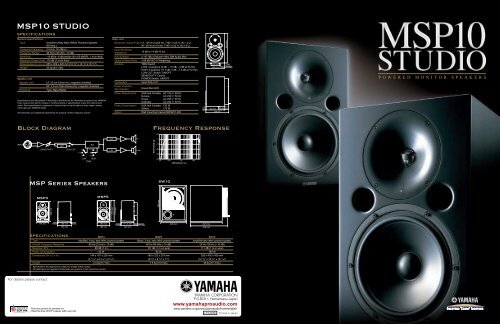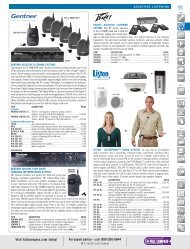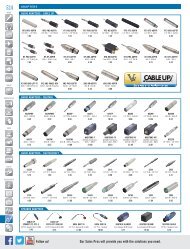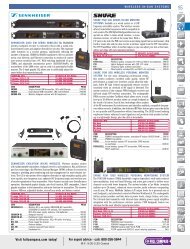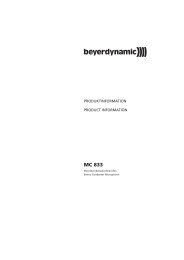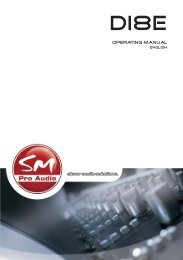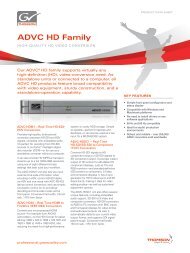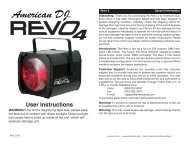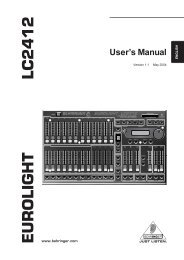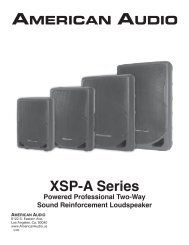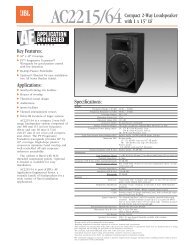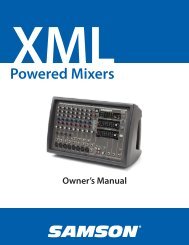You also want an ePaper? Increase the reach of your titles
YUMPU automatically turns print PDFs into web optimized ePapers that Google loves.
<strong>MSP10</strong> <strong>STUDIO</strong><br />
SPECIFICATIONS<br />
General specifications<br />
Type Amplified 2Way Bass Reflex Powered Speaker<br />
(Bi-Amp.)<br />
Crossover Frequency. 2.0 kHz, 30 dB/oct<br />
Frequency Range 40 Hz to 40 kHz (–10 dB)<br />
Sensitivity –10 dB at –6 dB position (for 100 dB/SPL, 1 m on Axis)<br />
Maximum Output Level 110 dB (1 m on Axis)<br />
Dimensiones (W x D x H) 265 x 329 x 420 mm (10 3 /8" x 12 7 /8" x 16 1 /2")<br />
Weight 20 kg (44.1 lbs)<br />
Speaker unit<br />
Speaker Unit LF: 20 cm Cone (4 Ω, magnetic shielded)<br />
HF: 2.5 cm Titan Dome (8 Ω, magnetic shielded)<br />
Enclosure Type: Bass Reflex<br />
Specifications and descriptions in this product brochure are for information purposes only. YAMAHA<br />
Corp. reserves the right to change or modify products or specifications at any time without prior<br />
notice. Since specifications, equipment or options may not be the same in every region, please<br />
check with your YAMAHA dealer.<br />
All trademarks and registered trademarks are property of their respective owners.<br />
Block Diagram Frequency Response<br />
INPUT<br />
SENSITIVITY<br />
MSP3<br />
LOW HIGH 1 LINE 2<br />
144 mm<br />
For details please contact:<br />
236 mm<br />
HPF<br />
LOW CUT<br />
6 mm 155 mm<br />
167 mm<br />
6 mm<br />
This document is printed on<br />
chlorine-free (ECF) paper with soy ink.<br />
0<br />
–1.5<br />
+1.5<br />
0<br />
EQ<br />
–3 –1.5<br />
LOW HIGH<br />
TRIM<br />
MSP Series Speakers<br />
SPECIFICATIONS<br />
MSP5<br />
160 mm<br />
169 mm<br />
Amp. unit<br />
Maximum Output Power LF: 120 W at 400 Hz, THD= 0.02 %, RL= 4 Ω<br />
HF: 60 W at 10 kHz, THD= 0.02 %, RL= 8 Ω<br />
Input Sensitivity/<br />
Impedance<br />
–6 dB to +4 dB/10 kΩ<br />
Hum & Noise –67 dBu (Volume= Min) DIN Audio filter<br />
Signal to Noise Ratio 98 dB (IEC-A Weighting)<br />
Controls TRIM Switch<br />
LOW: 3 positions (0 dB, –1.5 dB, –3 dB at 50 Hz)<br />
HIGH: 3 positions (+1.5 dB, 0 dB, –1.5 dB at 10 kHz)<br />
LOW CUT Switch: ON/OFF<br />
SENSITIVITY Control<br />
POWER Switch: ON/OFF<br />
Connectors Input XLR-3-31<br />
Power Indicator/<br />
Clip Indicator<br />
Green/Red LED<br />
Power Requirement USA and Canada: AC 120 V, 60 Hz<br />
Europe: AC 230 V, 50 Hz<br />
Korea: AC 220 V, 60 Hz<br />
Australia: AC 240 V, 50 Hz<br />
Power Consumption USA and Canada: 150 W<br />
Others: 170 W<br />
Option Wall mounting bracket BWS251-300<br />
HPF<br />
LPF<br />
270 mm<br />
279 mm<br />
Hi<br />
Low<br />
171.5 mm<br />
7 mm 43.5 mm<br />
222 mm<br />
RESPONSE (dB)<br />
+10<br />
0<br />
–10<br />
–20<br />
–30<br />
–40<br />
20<br />
459 mm<br />
SW10<br />
100<br />
1k<br />
FREQUENCY (Hz)<br />
10k<br />
5.5<br />
mm<br />
328 mm 407 mm<br />
476 mm<br />
120 mm 2-M8<br />
Screws<br />
265 mm<br />
www.yamahaproaudio.com<br />
www.yamaha.co.jp/product/proaudio/homeenglish<br />
420 mm<br />
61.5<br />
262 mm<br />
85 mm mm<br />
329 mm<br />
MSP3 MSP5 SW10<br />
Type Amplified, 2-way, bass-reflex powered speaker Biamp. 2-way, bass-reflex powered speaker Amplified bass-reflex powered speaker<br />
Overall Frequency Response 65 Hz-22 kHz (–10 dB) 50 Hz-40 kHz (–10 dB) 25 Hz-150 Hz (–10 dB)<br />
Maximum SPL 98 dB (1 m) 101 dB (1 m on axis) 111 dB (1 m on axis)<br />
Power Consumption 30 W 60 W 160 W<br />
Dimensions (W x D x H) 144 x 167 x 236 mm 169 x 222 x 279 mm 328 x 476 x 459 mm<br />
(5 11 /16" x 6 9 /16" x 9 5 /16") (6 5 /8" x 8 3 /4" x 11") (12 7 /8" x 18 3 /4" x 18 1 /16")<br />
Weight 4.4 kg (9.7 lbs) 7.5 kg (16.5 lbs) 26 kg (57.3 lbs)<br />
Specifications and appearance subject to change without notice.<br />
All trademarks and registered trademarks are property of their respective owners.<br />
LPA466E<br />
Printed in Japan<br />
POWERED MONITOR SPEAKERS
Near-perfect<br />
Evolution<br />
More than 30 years experience in the design and production of<br />
top-performance speaker systems has won<br />
Yamaha an enviable position in the recording<br />
field: respected professionals depend on<br />
Yamaha to help them achieve award-winning sound.<br />
The venerable NS10M <strong>STUDIO</strong> monitor speaker is an excellent<br />
example: from its introduction in the 80’s through to its recent<br />
discontinuation (due to unavailability of the necessary pure virgin<br />
pulp for its distinctive white woofer cone), the NS10M <strong>STUDIO</strong><br />
was the definitive near-field speaker monitor in an overwhelming<br />
majority of professional studios throughout the world. But times<br />
change, and technology must evolve. The <strong>MSP10</strong> <strong>STUDIO</strong> is<br />
an example of near-perfect evolution. It takes over where<br />
its predecessor left off with precision and performance<br />
that are perfectly suited to today’s production needs.<br />
The Yamaha <strong>MSP10</strong> <strong>STUDIO</strong> Powered Monitor is<br />
poised to become a cornerstone of the “new age” of<br />
audio production, in which advanced digital production<br />
consoles such as the Yamaha DM2000 and 02R96 as well as<br />
high-sample-rate digital source material and ultra-accurate<br />
reproduction media are rapidly becoming the norm.<br />
“Good” Sound Is Not<br />
Necessarily “Right” Sound<br />
The last thing an audio professional needs is flattering sound.<br />
They need the truth – precise reproduction that clearly reflects<br />
even the tiniest changes in EQ, dynamics, effects, or any of the<br />
multitude of parameters that add up to create the final sound.<br />
Thus, unlike many home-use systems that can simply be made to<br />
sound “good,” reference monitors have to sound “right,” and<br />
that’s an entirely different story. Here’s where inspired design,<br />
uncompromising material selection, innovative technology,<br />
micron-tolerance manufacturing, and a good dose of one elusive<br />
skill that only comes through long experience – knowing what<br />
“right sound” sounds like – become vitally important.<br />
The <strong>MSP10</strong> <strong>STUDIO</strong> design team, headed by Akira Nakamura,<br />
designer of the original NS10M, has all the necessary skills,<br />
resources, and dedication. And with development assistance and<br />
feedback from industry luminaries, the Yamaha <strong>MSP10</strong><br />
<strong>STUDIO</strong> delivers performance you can bet your career on.<br />
Powered for Consistent<br />
Quality & Convenience<br />
In any situation speakers are part of an interactive “system.”<br />
This includes the speakers themselves, the amplifier that is<br />
driving them, and the room in which they are used. Ideally, all<br />
of these elements must be carefully controlled to achieve<br />
optimum performance. By integrating the power amplifiers and<br />
speakers, at least part of the equation can be kept under perfect<br />
control (the room is up to the user). The <strong>MSP10</strong> <strong>STUDIO</strong><br />
power amplifier/speaker system is ideally matched and<br />
precisely tuned to achieve the best possible performance. Of<br />
course, the power amplifiers themselves are of the finest quality.<br />
And unlike component power amplifiers which must be<br />
<strong>MSP10</strong> <strong>STUDIO</strong> FEATURES<br />
designed for acceptable (read: “compromised”) matching with<br />
the widest possible range of speakers, the <strong>MSP10</strong> <strong>STUDIO</strong>’s<br />
amplifiers are designed and manufactured specifically to drive<br />
the system’s woofer and tweeter – specifically in the <strong>MSP10</strong><br />
<strong>STUDIO</strong> enclosure. No matter where the <strong>MSP10</strong> <strong>STUDIO</strong><br />
monitors are used, and with what sources or other audio gear,<br />
you know that you’re always receiving the benefits of a<br />
perfectly matched power amplifier and speaker system. You’ll<br />
hear the difference. You’ll also benefit from the convenience of<br />
not having to deal with external amplifiers and cabling.<br />
Advanced Bi-amp Design<br />
There are a number of advantages to multi-amp speaker setups,<br />
but many people shy away from the added cost and extra<br />
equipment required. With the <strong>MSP10</strong> <strong>STUDIO</strong> everything you<br />
need is built-in – all you have to do is supply the line-level<br />
input. The 8-inch cone woofer is driven by a 120-watt power<br />
amplifier, while the 1-inch titanium-dome tweeter has its own<br />
60-watt power amplifier. In the <strong>MSP10</strong> <strong>STUDIO</strong> this particular<br />
power and impedance combination results in the perfect<br />
balance between the low-mid and high frequency ranges.<br />
The frequency ranges are divided via a carefully designed<br />
electronic crossover before the power amplifier inputs,<br />
featuring steep 30-dB/octave roll-off curves in both the lowand<br />
high-pass filters. The steep roll-off minimizes intermodulation<br />
between the frequency bands at the crossover point,<br />
achieving significantly smoother, cleaner crossover<br />
performance in the critical midrange. And the fact that the<br />
crossover is a line-level electronic design completely<br />
eliminates the loss, distortion, and sometimes severe intermodulation<br />
that are almost unavoidable in conventional passive<br />
crossover networks driven by a single power amplifier.
<strong>MSP10</strong> <strong>STUDIO</strong> FEATURES <strong>MSP10</strong> <strong>STUDIO</strong> FEATURES<br />
The Drivers – Where<br />
Materials and Precision<br />
Manufacturing Really Count<br />
The <strong>MSP10</strong> <strong>STUDIO</strong> woofer and tweeter units feature some<br />
important design innovations that contribute directly to improved<br />
sound quality. The 8-inch woofer, for example, features a mineralimpregnated<br />
polypropylene cone with low-damping rubber<br />
surrounds for exceptionally smooth response. Low-reflection highrigidity<br />
die-cast magnesium baskets both maximize mechanical<br />
precision while minimizing unwanted coloration of the speaker’s<br />
output. The 1-inch tweeters feature titanium domes that offer the<br />
perfect combination of light weight and rigidity for precise<br />
reproduction right up to 40 kHz. The tweeters have an exceptionally<br />
powerful 17,000 gauss magnetic circuit that results in extremely fast<br />
response for crisp, natural transients, and are integrated with a<br />
waveguide that achieves uniform high-frequency dispersion of 120<br />
degrees. But if there’s one thing that sets the <strong>MSP10</strong> <strong>STUDIO</strong><br />
drivers apart from the rest, it’s not so much what they’re made of as<br />
how they’re made: precision, micron-tolerance manufacturing. The<br />
slightest eccentricity in the alignment of the tweeter domes and<br />
waveguides, for example, can seriously affect performance. So can<br />
the alignment of the coils and magnetic circuits. These are details<br />
that require a considerable investment of energy and resources to do<br />
properly, and they are exactly the details that make the <strong>MSP10</strong><br />
<strong>STUDIO</strong> the superior studio monitor that it is.<br />
Magnetic Shielding That Won’t<br />
Distort Your Sound<br />
In today’s production environment, which often includes computer and<br />
video displays as well as a range of magnetic media, magnetic<br />
shielding is essential. Conventional magnetic shielding schemes have<br />
the unfortunate side effect of distorting the magnetic flux of the<br />
speaker’s critical magnetic circuit. The end result is distorted sound.<br />
This was one of the biggest obstacles the <strong>MSP10</strong> <strong>STUDIO</strong> design<br />
team had to face, but one they overcame with a new “advanced<br />
magnetic structure” that achieves effective shielding while maintaining<br />
the integrity of the speaker’s magnetic circuit for significantly lower<br />
distortion as well as an improved definition.<br />
Consistent Magnetic<br />
field direction<br />
Random Magnetic<br />
field direction<br />
Advanced Magnetic structure<br />
Normal Magnetic structure<br />
Steel Yoke<br />
Main Magnet<br />
Shielding Magnet magnetized<br />
in reverse direction<br />
And Don’t Forget the<br />
Enclosures …<br />
Yes, the boxes are part of the system too, and demand as much<br />
attention as the electronics and drivers themselves. The <strong>MSP10</strong><br />
<strong>STUDIO</strong>’s bass-reflex enclosure is constructed from high-quality<br />
MDF (Medium Density Fiber) and braced to eliminate colorationcausing<br />
resonance. Resonance-free operation is further ensured by<br />
a painstaking 9-step finishing process that includes no less than 5<br />
layers of piano-finish paint. The result of all this attention to detail<br />
is response that is so natural and transparent that you can hear<br />
details even in delicate decays and reverb tails.<br />
SW10<br />
Powered Subwoofer<br />
MSP5<br />
Biamp. 2-way, bass-reflex<br />
Powered Monitor speaker<br />
Connectors and Controls<br />
The <strong>MSP10</strong> <strong>STUDIO</strong> features a balanced XLR-type connector for<br />
input. This provides direct compatibility with professional gear<br />
and allows the use of balanced lines for maximum audio quality<br />
even where long cable runs are required. Rear-panel controls<br />
include an input sensitivity control with a –6 dB ~ +4 dB range,<br />
and trim switches that enable you to adjust the bass and treble in<br />
three positions. (0 dB, –1,5 dB, –3 dB at 50 Hz and +1,5 dB, 0 dB,<br />
–1,5 dB at 10 kHz) – allowing the system’s response to be quickly<br />
matched to the room. There’s also a low cut (80 Hz) switch that is<br />
useful when the <strong>MSP10</strong> <strong>STUDIO</strong> is used with the SW10 Subwoofer.<br />
For convenient wall mounting Yamaha offers<br />
an optional BWS251-300 Wall Bracket.<br />
Rear Panel<br />
MSP3<br />
2-way, bass-reflex<br />
Powered Monitor speaker<br />
BWS251-300<br />
MSP<br />
Series<br />
Speakers<br />
Deliver<br />
High<br />
Quality<br />
Performance
I N T E R V I E W<br />
An Interview With the Man Behind the Sound<br />
In order to learn as much as possible about the <strong>MSP10</strong> <strong>STUDIO</strong> and its background, we talked directly to<br />
Akira Nakamura, head of the <strong>MSP10</strong> <strong>STUDIO</strong> design team. Nakamura was also the brain behind the<br />
legendary NS10M and NS10M <strong>STUDIO</strong>. Here are some of his comments:<br />
Interviewer: What were the first projects you<br />
were involved in at Yamaha?<br />
Nakamura: It was speakers right from the very<br />
beginning, but the first ones I worked on were for<br />
musical instruments – Yamaha Electone organs, to<br />
be specific. We couldn’t get the sound we wanted<br />
from speakers purchased from other<br />
manufacturers, so we started developing and<br />
manufacturing our own.<br />
Hi-fi speakers weren’t an issue back then?<br />
Not in the beginning. I joined the company and<br />
started working on musical instrument speakers in<br />
around 1965, but serious development of hi-fi<br />
speakers wasn’t started until about 1970.<br />
What audio speakers did you work on prior<br />
to the NS10M?<br />
Most of them, but perhaps the most notable was<br />
the Yamaha NS1000M. I think we released it in<br />
around 1974. The NS1000M became one of the<br />
longest-selling hi-fi speakers, ever. As I remember,<br />
the NS10M was released several years later,<br />
in about 1978.<br />
Was the NS10M an instant success?<br />
In the home-use market, yes. It wasn’t until several<br />
years later that studios began adopting the NS10M<br />
for near field monitoring. This was because it was<br />
originally developed for the home market, and was<br />
only sold through outlets targeted at the home<br />
market. But once the studio people caught on,<br />
we had to expand our retail routes to include the<br />
pro-audio market.<br />
Interview<br />
Why did the NS10M become the industry<br />
standard for audio production?<br />
At the time, most studios were using small single-unit<br />
cube-shaped speakers for near-field monitoring –<br />
actually they were probably used mostly to hear how<br />
projects might sound on a boom-box or car stereo.<br />
But the engineers were looking for a compact monitor<br />
with a bit more power and a wider frequency range, as<br />
well as something that more accurately represented the<br />
home audio sound of the time. The NS10M was<br />
perfect. It also had the midrange definition that the<br />
engineers needed for rock and pop production, and<br />
eventually became the engineers’ primary tool for<br />
sound creation and mixing, rather than simply a means<br />
to hear the results on a less-than-perfect system. It<br />
wasn’t long before you could walk into just about any<br />
major studio and find a pair of NS10Ms sitting on the<br />
console meter bridge. This was an advantage for the<br />
engineers, because they were familiar with the NS10M<br />
sound and could expect the same quality in just about<br />
any studio, anywhere in the world.<br />
So Yamaha didn’t start out to deliberately<br />
create a studio monitor speaker?<br />
Not really. We were only interested in achieving the<br />
cleanest, most natural reproduction possible.<br />
As it turned out, what we were trying to achieve was<br />
precisely what the audio production professionals<br />
were looking for.<br />
The white NS10M woofer cone was quite<br />
distinctive, is there a story behind the color?<br />
We were in the process of trying out different pulps<br />
and papers for use in speaker cones, but nothing gave<br />
us the sound we wanted. Looking for the cleanest,<br />
most impurity-free cone paper we could find, we<br />
eventually came across a type of especially pure pulp<br />
that a photographic-materials manufacturer was<br />
using. That was our answer.<br />
The “NS10M <strong>STUDIO</strong>” was introduced in 1987.<br />
What was the story behind that development?<br />
In addition to optimizing the design for horizontal<br />
placement, there was the “tissue paper issue”. There<br />
was a period in which the pro-audio magazines and<br />
papers were full of articles about how engineers were<br />
placing layers of tissue paper in front of the NS10M<br />
tweeters to give them the balance they needed. There<br />
were even arguments as to how many layers of tissue<br />
paper gave the best response, how far it should be<br />
placed in front of the tweeter, and so on. So we sat<br />
down with the speakers – and a supply of tissue paper<br />
– and began an extensive series of tests. The overall<br />
balance of the NS10M-plus-tissue idea was fine but, as<br />
you would expect, some of the high-frequency<br />
definition was lost. We figured out a way to deliver the<br />
required balance without losing detail, and that<br />
became the NS10M <strong>STUDIO</strong>.<br />
After selling more than 200,000 units, NS10M<br />
<strong>STUDIO</strong> was discontinued in 2001, causing<br />
great shock to the engineers and the industry.<br />
Why was it discontinued?<br />
The white cones. Due to a number of unavoidable<br />
reasons it has become impossible to continue<br />
manufacturing those cones. Without those cones there<br />
can be no NS10M. Fortunately, we were able to<br />
produce enough maintenance units to keep current<br />
users supplied for several years. Also, it was about the<br />
time that the NS10M <strong>STUDIO</strong> was being widely<br />
adopted that we began work on the MSP series<br />
speakers with the goal of providing powered<br />
convenience with superior frequency response and an<br />
extended low end. Now that the <strong>MSP10</strong> <strong>STUDIO</strong> has<br />
been perfected, there’s really no better choice.<br />
Tell us something about the new <strong>MSP10</strong><br />
<strong>STUDIO</strong>: what were the main sonic goals<br />
behind its development?<br />
There are other popular powered monitor speakers on<br />
the market that have a nice “comfortable” sound, but<br />
we came to the conclusion that they weren’t really<br />
accurate enough for critical monitoring applications.<br />
We wanted to create a monitor that delivers the source<br />
without “softening” it in any way. Engineers need to<br />
hear frequency, they need to hear dynamics, imaging,<br />
separation … there are so many parameters that must<br />
be kept under control. The <strong>MSP10</strong> <strong>STUDIO</strong> was<br />
designed from the outset to allow the listener to hear<br />
every single aspect of the sound as clearly as possible<br />
so that he or she can make the most effective creative<br />
decisions and sonic adjustments. If a slight change is<br />
made to the EQ on one track, you need to hear it. If the<br />
reverb time of the ambience used on the vocal track is<br />
adjusted by a fraction of a second, you need to hear<br />
that, too. Once we knew what we wanted to achieve,<br />
we had to translate those concepts into actual design<br />
parameters and refinements – drivers, amplifiers,<br />
crossover, enclosure, finish – everything counts.<br />
The original <strong>MSP10</strong> and the new <strong>MSP10</strong><br />
<strong>STUDIO</strong> look quite similar – how can we tell<br />
them apart?<br />
Visually the only difference is in the location of the<br />
Yamaha logo (in the <strong>MSP10</strong> <strong>STUDIO</strong> it is below the<br />
woofer), and the fact that the radius of the enclosure<br />
corners is a little sharper in the new version.<br />
The main differences, however, are internal. It’s the<br />
difference between sound designed for listening and<br />
sound designed for monitoring, and that meant<br />
making significant refinements to the midrange<br />
performance and crossover parameters as well as<br />
parts and assembly precision.<br />
How does the <strong>MSP10</strong> <strong>STUDIO</strong> fit in with<br />
modern monitoring practices?<br />
These days many engineers monitor at low levels.<br />
Paradoxically, this allows them to hear detail that<br />
gets “washed out” at higher levels. When we tested<br />
other powered monitor systems we discovered that<br />
they tended to lose definition at such low levels, so<br />
we put a great deal of effort into ensuring that the<br />
<strong>MSP10</strong> <strong>STUDIO</strong> stayed clean and precise right<br />
down to the lowest levels.<br />
How about surround monitoring?<br />
Of course, the <strong>MSP10</strong> <strong>STUDIO</strong> is an ideal monitor for<br />
surround applications. The 120° dispersion of the<br />
tweeter waveguide makes it a perfect choice for<br />
surround setups – plus the fact that is basically an<br />
excellent monitor speaker.<br />
Were there any major obstacles to achieving<br />
the desired performance?<br />
Many. But the areas that required the most time and<br />
energy were probably the actual manufacturing<br />
processes. In order to achieve the desired high quality<br />
consistently in all units, we had to dramatically<br />
increase the dimensional precision of all parts, as well<br />
as the assembly procedures used to put them together.<br />
What is different about the new “advanced<br />
magnetic circuit”?<br />
Speaker engineers who are serious about sound<br />
quality have known about the problems with<br />
magnetic shielding for quite some time.<br />
Magnetically-shielded speakers have a “cancellation<br />
circuit”, which is basically a reverse-polarity magnet<br />
attached to the back of the speaker’s normal<br />
magnetic circuit. Conventional cancellation circuits<br />
consist only of a magnet and outer yoke — a<br />
configuration which results in a random flux pattern<br />
when magnetized. This disturbs the magnetic field of<br />
the main magnet and has a deleterious effect on the<br />
sound. With the new “advanced magnetic circuit”, an<br />
extremely consistent flux pattern is produced in the<br />
“shield” magnet by placing it between inner and<br />
outer yokes at the magnetizing stage. The result is<br />
significantly improved sound quality.<br />
I N T E R V I E W<br />
Why is the <strong>MSP10</strong> <strong>STUDIO</strong> so heavy?<br />
(The <strong>MSP10</strong> <strong>STUDIO</strong> weighs 20 kg, compared<br />
to about 12 kg for the leading competitor.)<br />
Well, being heavier is not something we can really<br />
brag about, but in the process of optimizing overall<br />
performance we simply ended up with a heavier<br />
enclosure, heavier woofer, and heavier transformers<br />
in the amplifiers. We weren’t prepared to<br />
compromise performance for reduced weight.<br />
How large a factor is the reduced radius of<br />
the <strong>MSP10</strong> <strong>STUDIO</strong> enclosure corners?<br />
The change is subtle, but it does make a significant<br />
difference to the sound. By simply changing the<br />
corner radius by a few millimeters we achieved<br />
noticeable better definition and imaging. This might<br />
be partly related to external diffraction, but it is more<br />
likely to be a result of the change in the structure and<br />
solidity of the corner joints that affects the overall<br />
performance of the enclosure.<br />
And what about the 9-process, 5-layer finish?<br />
Is it really that important?<br />
Very important. What’s on the surface of the<br />
enclosure has a significant effect on the way it<br />
responds. The right finish can effectively control<br />
unwanted resonance in the wood. The benefits of this<br />
are most noticeable in delicate decays and reverb<br />
tails – in the <strong>MSP10</strong> <strong>STUDIO</strong> they fade out most<br />
naturally, without a trace of coloration. The finish<br />
we’re using is very similar to the finish used on<br />
pianos. There’s no way to completely eliminate<br />
enclosure resonance, but we’ve succeeded in making<br />
it as transparent and “musical” as possible.<br />
Akira Nakamura<br />
Chief Engineer Speaker Development


